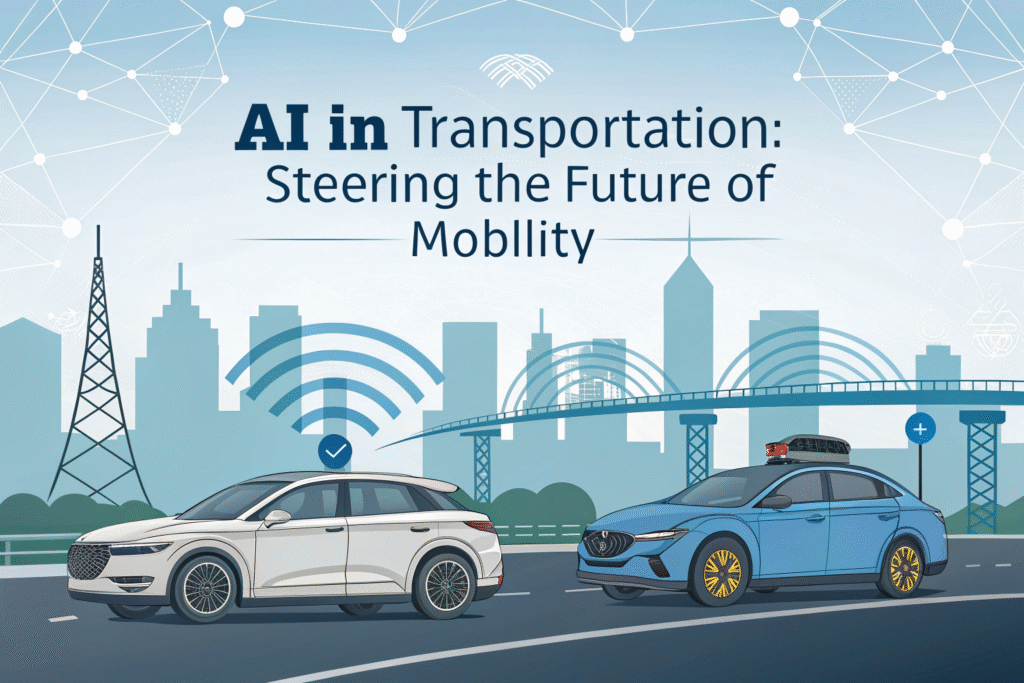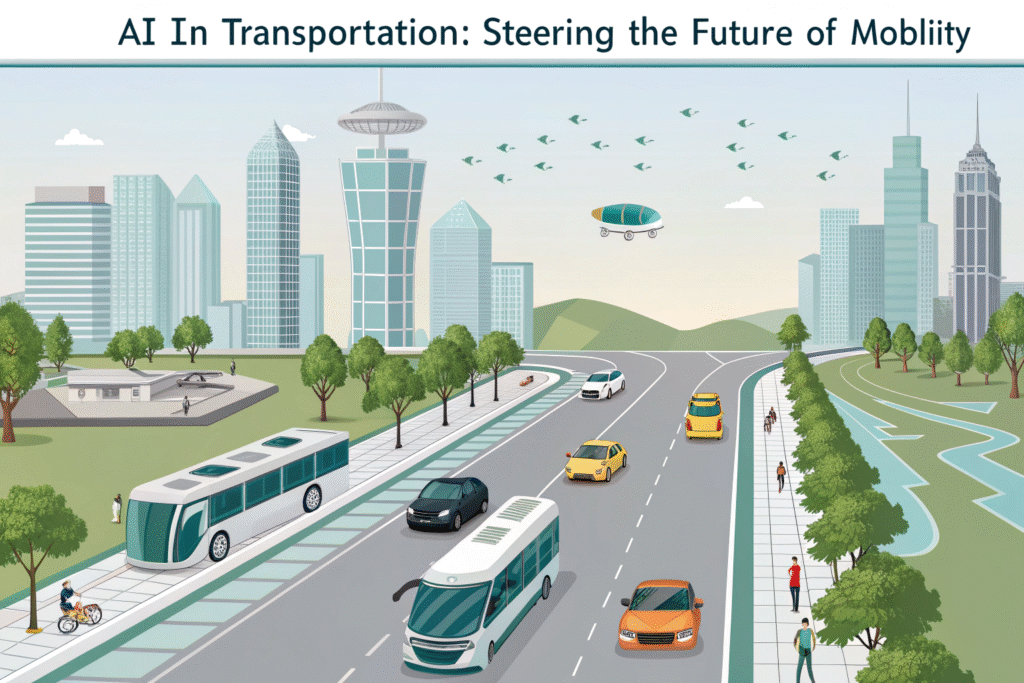
In fact, the way we move people and goods is experiencing its most significant transformation ever, comparable to the impact of the invention of the internal combustion engine. At the heart of this revolution is Artificial Intelligence (AI), a powerful force turning sci-fi concepts like self-driving cars into tangible realities. For entrepreneurs, marketers, and content creators, this shift isn’t just about technology; it’s about a fundamental change in consumer behavior, logistics, and urban planning. This article explores the journey of AI in transportation, its core applications, and the vast opportunities it presents for the future.
Introduction: The Road to Autonomy and Efficiency
Transportation is evolving from a system of human-operated vehicles on static routes to a dynamic, interconnected network of intelligent machines. AI in transportation is the catalyst, enabling systems to perceive their environment, make real-time decisions, and optimize for efficiency and safety on a massive scale. This shift promises to reduce congestion, lower emissions, and create entirely new business models.
History & Evolution: From Cruise Control to Cognitive Cars
The integration of AI has been a gradual acceleration.
- 1970s-1980s – Early Automation: The first inklings came with basic automation like anti-lock braking systems (ABS) and cruise control, which used simple computational rules.
- 1990s-2000s – Data and Logistics: The rise of GPS and digital mapping provided the data foundation. Meanwhile, logistics companies began using early algorithms for basic route optimization.
- 2010s-Present – The Sensing Revolution: Advancements in machine learning, computer vision, and sensor technology (LIDAR, radar) enabled the development of advanced driver-assistance systems (ADAS) and the first viable prototypes of autonomous vehicles.
Audience & Demographics: Who’s in the Driver’s Seat?
The impact of AI extends across the entire ecosystem:
- Consumers & Commuters: Benefit from ride-sharing apps with AI-powered matching, real-time navigation, and the promise of safer, self-driving personal vehicles.
- Logistics & Supply Chain Companies: Leverage AI for dynamic routing, predictive maintenance on fleets, and automated warehouse management.
- Urban Planners & Governments: Use AI to analyze traffic patterns, optimize public transit schedules, and manage smart city infrastructure.
- Automakers & Tech Entrepreneurs: Are at the forefront, developing the hardware and software that power autonomous driving and connected vehicle technologies.
Key Features & Functions Reshaping Mobility
AI’s value is delivered through several critical functions:
Autonomous Vehicles (AVs)
Using a combination of sensors and deep learning, AVs perceive their environment, identify obstacles, and navigate roads without human intervention.
Smart Traffic Management
AI algorithms analyze real-time data from cameras and sensors to optimize traffic light timing, manage flow, and reduce congestion in urban centers.
Predictive Maintenance
By analyzing data from vehicle sensors, AI can predict mechanical failures before they happen, minimizing downtime and improving safety for commercial fleets.
Route and Logistics Optimization
AI systems process countless variables—like weather, traffic, and delivery windows—to determine the most efficient routes for delivery trucks, saving time and fuel.
Demand Forecasting and Ride-Sharing
Platforms use AI to predict demand in specific areas, strategically positioning vehicles and setting dynamic pricing to balance supply and demand.
Business & Marketing Potential
The opportunities for innovative businesses are tremendous:
- New Mobility-as-a-Service (MaaS) Models: Subscription-based autonomous vehicle fleets or integrated multi-modal travel apps present entirely new revenue streams.
- Data-Driven Marketing: Companies can leverage mobility data to understand consumer movement patterns, enabling hyper-localized advertising and strategic brick-and-mortar placement.
- Enhanced Customer Experiences: From proactive vehicle maintenance alerts to seamless last-mile delivery notifications, AI allows for a more predictive and personalized customer journey.
Best Practices & Tips for Implementation
Successfully navigating this shift requires a strategic approach:
- Prioritize Data Infrastructure: AI thrives on data. Investing in robust data collection and management systems is the first critical step.
- First and foremost, focus on safety and security. In particular, for AVs, ensuring both cybersecurity and functional safety is non-negotiable because it helps gain public and regulatory trust.
- Collaborate Across Industries: The future of transportation is interconnected. Partnerships between automakers, tech companies, and city governments are essential.
- First, start with a pilot program. For example, focus on optimizing a single delivery route or alternatively, implement predictive maintenance on a small fleet so that you can clearly demonstrate value.
Challenges & Limitations
The road ahead has several speed bumps:
- Safety and Liability: Determining responsibility in the event of an accident involving an AI system remains a significant legal and ethical hurdle.
- High Development Costs: The R&D required for AI, particularly for autonomous vehicles, is extremely capital-intensive.
- Data Privacy Concerns: The extensive data collection necessary for these systems raises serious questions about user privacy and data ownership.
- Regulatory and Public Acceptance: Governments are struggling to keep pace with technology, and public skepticism about the safety of self-driving cars remains high.
Future Outlook: The Autonomous Horizon
The next decade will be defined by even greater integration:
- Full Autonomy (Level 5): The pursuit of fully self-driving cars in all conditions will continue, potentially revolutionizing personal mobility and freight transport.
- AI-Optimized Smart Cities: Transportation systems will become fully integrated with city infrastructure, leading to dramatically reduced congestion and pollution.
- Hyperloop and Advanced Mobility: AI will be crucial for managing the complex operations of next-generation high-speed transport. It will also ensure the safety systems function reliably.
- Sustainable Logistics: AI will play a central role in creating the most efficient routes for electric and hydrogen-powered vehicle fleets. This will accelerate the shift toward green logistics.

Conclusion: The Journey Ahead
Undoubtedly, the integration of AI in transportation is more than a technological upgrade; in fact, it represents a paradigm shift. Consequently, it promises a future with fewer accidents, less congestion, and a more efficient global supply chain. Furthermore, for entrepreneurs and marketers, this presents a landscape ripe with disruption and opportunity. However, challenges related to safety, regulation, and cost remain significant. Nevertheless, the direction of travel is clear, and progress continues steadily. Therefore, by embracing AI thoughtfully and strategically, we can ultimately steer toward a smarter, safer, and more sustainable future for everyone on the move. In addition, ongoing innovation and collaboration will also further accelerate these benefits